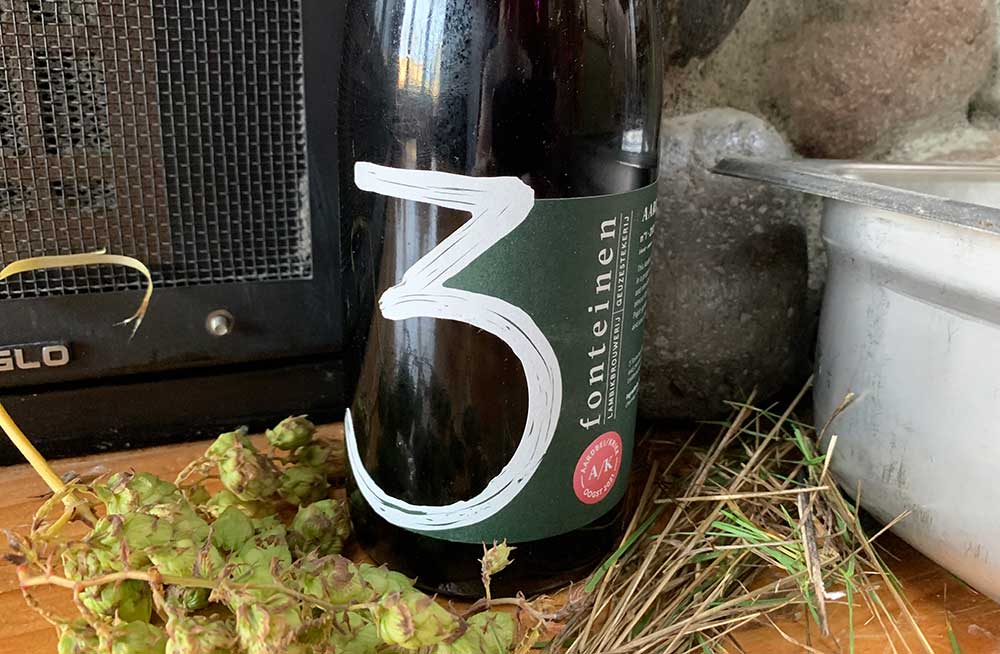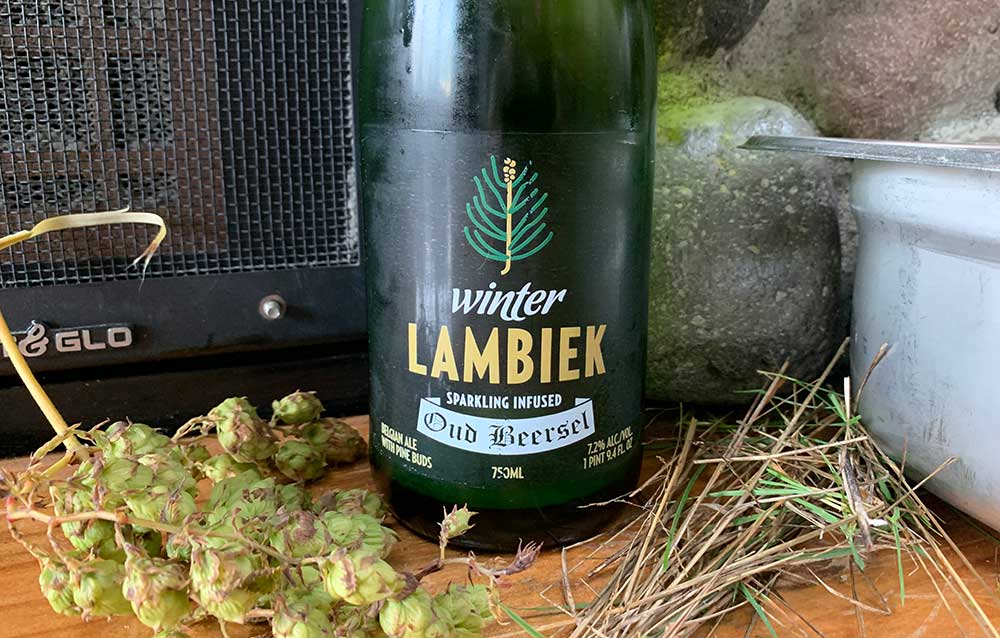 Peaks & Pints wants you to have a musty, old leather, barnyard, horse blanket, cheesy, fruity, and tart good time today, which should be easy to do since the Grit & Grain Podcast hosts local beer expert Scott Travis and his thoughts on lambics at 4:30 p.m. in our Event Room. Lambics — whether straight lambics, faro, gueuze, or fruit based — are produced only in one area of Belgium, the Senne River Valley, south and west of Brussels in the Pajottenland region. Officially speaking, lambic is an appellation — like “Champagne” and “bourbon” — and the use of the l-word is strictly enforced and reserved for beers made exclusively in said region. Most important of all, they’re beers that are spontaneously fermented by the airborne wild yeasts and bacteria present in this valley and nowhere else on the face of the Earth. Nature didn’t just bless this area with the right yeasts and bacteria — it also endowed it with an ideal climate for slow fermentation, easy access to French wine barrels, and even tart Schaerbeek cherries. The real beauty of these ales is how different they are from brewery to brewery, batch to batch, barrel to barrel. Hell, the beer even changes with each sip down the glass. Adventure is out there. It’s also our in-house flight today. Hang with Scott Travis and the Grit & Grain this afternoon while enjoying Peaks and Pints Beer Flight: Lambics.
Peaks & Pints wants you to have a musty, old leather, barnyard, horse blanket, cheesy, fruity, and tart good time today, which should be easy to do since the Grit & Grain Podcast hosts local beer expert Scott Travis and his thoughts on lambics at 4:30 p.m. in our Event Room. Lambics — whether straight lambics, faro, gueuze, or fruit based — are produced only in one area of Belgium, the Senne River Valley, south and west of Brussels in the Pajottenland region. Officially speaking, lambic is an appellation — like “Champagne” and “bourbon” — and the use of the l-word is strictly enforced and reserved for beers made exclusively in said region. Most important of all, they’re beers that are spontaneously fermented by the airborne wild yeasts and bacteria present in this valley and nowhere else on the face of the Earth. Nature didn’t just bless this area with the right yeasts and bacteria — it also endowed it with an ideal climate for slow fermentation, easy access to French wine barrels, and even tart Schaerbeek cherries. The real beauty of these ales is how different they are from brewery to brewery, batch to batch, barrel to barrel. Hell, the beer even changes with each sip down the glass. Adventure is out there. It’s also our in-house flight today. Hang with Scott Travis and the Grit & Grain this afternoon while enjoying Peaks and Pints Beer Flight: Lambics.
Peaks and Pints Beer Flight: Lambics
 Lindemans Strawberry
Lindemans Strawberry
4.1% ABV
Lindemans Strawberry fruited lambic has complex sweetness from the strawberries matching perfectly with the sourness of lambic, resulting in a unique balanced marriage of sweet and sour. The recipe was developed specifically for the ever-developing tastes in the US market. It sports a rosy hue, with an aroma of ripened strawberries. Shows complex, captivating flavors; delicate sweetness is balanced by traditional lambic tartness in the finish.
 Gueuze Girardin 1882 Black Label
Gueuze Girardin 1882 Black Label
5% ABV
The Girardin family has been making beer since 1882 when they acquired the farm and its small brewery in the village of Sint-Ulriks-Kapelle near Brussels. For most of the history of the family business, the farm has been the primary focus for the family. It’s only been in recent decades that Brouwerij Girardin has become more prominent. Despite this increase in focus, the Girardin family is renowned for their secrecy and almost never allow anyone into their brewery. Also, most of their production is sold as wort to blenders such as 3 Fonteinen, Hanssens, De Cam, and Tilquin. Girardin Gueuze 1882, sometimes known as “Black Label,” is both unfiltered and unpasteurized. Instead of the traditional gueuze blend of 1-, 2-year- and 3-year-old lambic, Girardin 1882 is a blend of 12-, 18- and 24-month-old lambic. It hits the nose with sweet orange and apricot, plus lactic tartness earthy hay-like notes, moderate sharp Brett aroma, light strawberry and plum. From the first sip, flavors of lemongrass, creamy oak, minerals, funky horse blanket, yeast, and slight stone fruit sweetness flit in and out, with none more dominant than the rest. It’s funky, rustic, complex, and super tasty.
 Hanssens Lambic Experimental Raspberry
Hanssens Lambic Experimental Raspberry
6% ABV
Hanssens Artisanaal is a traditional lambic blendery located in Dworp (Tourneppe), Belgium. It’s the oldest independent gueuze blender in the world. Before moving to their current site in 1896, lambic was brewed and blended at the family farm since 1871. Hanssens, as we know it today, came into existence through a non-lambic brewery known as Het Hooghuys brewery. This brewery was initially owned by the Van Hemelrijk family and eventually became associated with the Hanssens name after Petrus Van Hemelrijk married Joanna Maria Hanssens in 1837. Peaks & Pints tapped Hanssens Lambic Experimental Raspberry cask. On the nose, this framboise has Brettanomyces aromas of hay and barnyard, plus light raspberry and seeded fresh fruit, as well as lactic acid and citrus. The flavor is bright with raspberry fruit and tannins, with predominately lactic acidity. Some citrus notes and the faintest bit of acetic acid are also present. It finishes with Brett character in the flavor was mostly present in the finish, starting with wet sour dough, and finishing with distinct horse notes, as well as a little sweat.
 Drie Fonteinen Aardbei Kriek Blend No. 1 21/22
Drie Fonteinen Aardbei Kriek Blend No. 1 21/22
6.2% ABV
Brouwerij 3 Fonteinen, or Drie Fonteinen, focuses on aging and blending the beers of other lambic brewers. It’s a particularly Belgian concept that the creative process in producing a beer comes not when its ingredients are combined and fermented, but in how the resulting beer is aged and blended with other vintages to create a new transcendent concoction. Their Aardbei/Kriek is a blend of a strawberry lambic and a sour cherry lambic, in a proportion of 65/35. The lambikken originate from five different barrels and nine different brews. Most of them were 2-year-old lambikken, and almost 10 percent 3-year-old. One third of the lambic volume is brewed with Pajot-grown cereals. The final fruit concentration is 516 grams of strawberries and sour cherries used per liter of finished Aardbei/Kriek.
 Brouwerij Oud Beersel Winter Lambiek
Brouwerij Oud Beersel Winter Lambiek
7.2% ABV
Brouwerij Oud Beersel, located near Brussels in the town of Beersel, is one of the last remaining authentic lambic breweries in Belgium. Founded in 1882 by Henri Vandervelden, the small brewery remained family-owned for four generations until 2002, when financial woes forced operations to cease, and the brewery all but closed. In 2005, fearing the brewery’s unique artisanal lambics could be lost forever, friends Gert Christiaens and Roland De Bus took a chance and reopened the business and, with the help of Frank Boon, owner of the Boon Brewery, relaunched the Oud Beersel line to great success. Oud Beersel’s infused lambic with pine buds, Winter Lambiek, combines the refreshing character of lambic and the flavor of pine trees.
LINK: Peaks & Pints beer and cider cooler inventory
